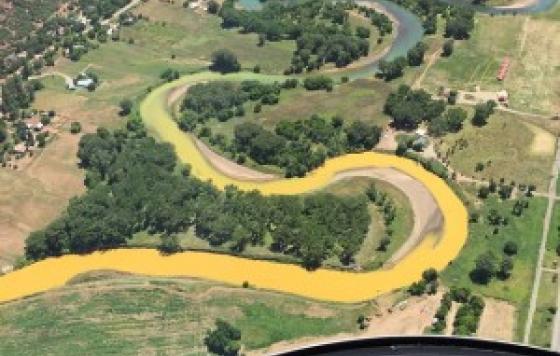By Gary Wockner, Colorado Program Director
Originally posted at Huffington Post
Oil and gas drilling and fracking pose extraordinary threats to Colorado's Denver metro and Front Range cities including to air quality, water quality in streams and groundwater, wildlife habitat, private property rights, and landscape health. These impacts are generally similar wherever drilling and fracking occurs across the U.S.
But what makes drilling and fracking unique in Colorado -- and especially across Colorado's Front Range from Fort Collins to Pueblo -- is its threat to Colorado's rivers.
Why? Drilling and fracking use
a lot of water, and water is already in short supply along the Front Range. In fact, many fast-growing Colorado cities predict they will have a shortage of water in the next decade and are already proposing new water supply projects that will further drain Colorado's already severely degraded rivers. And, the very same cities that are proposing new water projects are also selling increasing amounts of water for fracking.
First, the Windy Gap Firming Project proposes to drain up to an additional
30,000 acre feet (nearly 10 billion gallons) of water out of the severely degraded Upper Colorado River every year and pipe and pump that water to northern Front Range Colorado cities including Loveland, Longmont, and Greeley. At the very same time, those same three cities have recently started selling water for fracking, and Greeley has started selling large quantities for fracking -- over
1,500 acre feet (500 million gallons) in 2011 and climbing. The Upper Colorado already has 60 percent of its water drained out and has severe problems with water quality and water temperature such that fish and aquatic insects are on the brink of survival.
(Click here to view a satellite image of 142 water tankers surrounding a frack site south of Greeley, Colorado)
Second, the Northern Integrated Supply Project proposes to drain an additional
40,000 acre feet (13 billion gallons) per year out of the Cache la Poudre River northwest of Fort Collins. Several towns and cities participating in this project are already selling water for fracking including
Windsor,
Fort Lupton, Eaton, Firestone, and the Central Weld County Water District. Unfortunately, the Cache la Poudre is one of the most endangered rivers in America, already has over
60 percent of its water drained out before the river reaches downtown Fort Collins, and is sometimes
drained completely dry.
Third, the Seaman Reservoir Project by the City of Greeley on the North Fork of the Cache la Poudre River proposes to
drain several thousand acre feet of water out of the North Fork and the mainstem of the Cache la Poudre. Greeley's water sales for fracking, noted above, are escalating.
Fourth, one of the biggest proposed projects in Colorado is the Flaming Gorge Pipeline which could take a massive amount of water -- up to
250,000 acre feet (81 billion gallons) -- out of the Green and Colorado River systems every year and pipe and pump that water to the Front Range. One of the proponents for that project was quoted in the
Denver Post as saying, "If this new water supply helps with the fracking issues, then, without question, we would consider delivering water for the industry." Downstream from this proposed diversion, the Colorado River's health and endangered fish species are already struggling to survive.
Fifth are several to-be-determined water sales for fracking. The City of Denver has opened up
drilling and fracking on its property at Denver International Airport. It is unclear at this time who is selling water to those drilling and fracking operations, but the City of Denver is also pushing forward with the
Moffat Collection System Project, a proposal to drain even more water out of the Upper Colorado River and pipe it to Denver. Also, the City of Aurora has
drilling and fracking moving into its east Denver suburbs, including at the former Lowry Bombing Range surrounding Aurora Reservoir -- it is
unclear where those drillers and frackers will get water but they will need a lot of it. In addition, the City of Thornton is planning to
grow to the northeast across E-470 into drilling/fracking territory and is at the same time planning to
divert tens-of-thousands of acre feet of water out of the Cache la Poudre watershed which is 50 miles to the north to slake the thirst of that growth.
And the list goes on and on, from Pueblo to Colorado Springs to the Southern suburbs of Denver as drilling and fracking move into suburban Front Range Colorado near homes and families, but also near city-owned fire hydrants that provide quick, cheap, clean water that has and will be diverted out of Colorado's endangered rivers.
So, how much water will fracking take? Like all things with fracking, there are differences of opinion. The industry-funded Colorado Oil and Gas Association estimates that water used for fracking could be
20,000 acre feet (6.5 billion gallons) per year as wells are sunk in the suburban Front Range. But some environmentalists believe that number
would be higher as tens-of-thousands of new wells are drilled and fracked, as old wells are re-fracked, and as that water is never returned to the hydrologic cycle because it is too poisoned and polluted for other uses. In addition, efforts in the 2012 Colorado State Legislature to require drillers and frackers to publicly disclose the amount of water they have used have not yet been successful.
Unfortunately, the federal government does not appear to be taking the issue seriously. Recently, the U.S. Bureau of Reclamation released its "Final Environmental Impact Statement" (FEIS) for the Windy Gap Firming Project (noted above) and although several of the project's participating cities are selling water for fracking, the
FEIS does not analyze nor mention this use of water even after environmentalists have repeatedly requested it. Environmentalists have
requested similar analyses for the other projects listed above -- federal agencies have not yet responded to those requests.
It is true that the state of Colorado contains millions of acre feet of water, and that fracking may only need a
small percentage of it. But more importantly and to the point, it is also true that fracking is a brand new use of water, and that the brand new amount of water needed for fracking is coming from many of the same cities that are proposing brand new water projects that will further dam, drain, and divert the last streamflows out of Colorado's rivers.
Some people say that fracking may be a small drop in the bucket of Colorado's overall water supplies, but if these water projects go forward, fracking would certainly contribute to being the last drop in the bucket of Colorado's rivers.



